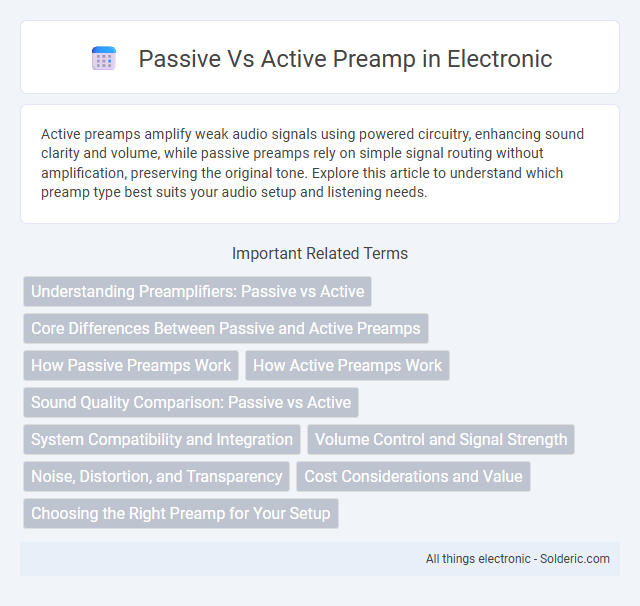Active preamps amplify weak audio signals using powered circuitry, enhancing sound clarity and volume, while passive preamps rely on simple signal routing without amplification, preserving the original tone. Explore this article to understand which preamp type best suits your audio setup and listening needs.
Comparison Table
| Feature | Passive Preamp | Active Preamp |
|---|---|---|
| Power Requirement | No external power needed | Requires external power or battery |
| Signal Amplification | No amplification, signal passes through | Amplifies and boosts signal strength |
| Sound Quality | Natural tone, can lose high frequencies with long cables | Consistent tone, preserves signal integrity over long cables |
| Control | Typically offers only volume control | Offers volume and tone shaping options |
| Noise Level | Minimal noise, but signal can degrade | Potentially introduces noise but maintains signal clarity |
| Common Applications | Simple setups, vintage instruments | Professional rigs, complex audio setups |
Understanding Preamplifiers: Passive vs Active
Passive preamps offer simple signal boosting without power, relying on your amplifier's gain stage and preserving the pure tone of your instrument, making them ideal for minimal signal alteration. Active preamps, powered by batteries or external sources, provide onboard gain control, equalization, and enhanced signal strength, resulting in greater tonal flexibility and reduced signal loss over long cable runs. Understanding the difference between passive and active preamps helps you choose the best setup to match your instrument, playing style, and desired sound output.
Core Differences Between Passive and Active Preamps
Passive preamps rely solely on your guitar's pickups and tone controls, offering a pure, uncolored signal without any internal amplification or power source. Active preamps include built-in amplification powered by a battery or external source, allowing for boosted signal strength, enhanced tone shaping, and greater control over volume and EQ. Understanding these core differences helps you choose the right preamp to maintain signal integrity or achieve a more dynamic sound in your audio setup.
How Passive Preamps Work
Passive preamps operate by using simple components like resistors and capacitors to control the signal level without adding any amplification or coloration. They rely on the natural impedance and the gain from your amplifier or active preamp stage to boost the audio signal, preserving the original tone with minimal noise or distortion. Understanding how passive preamps work can help you maintain sonic purity while allowing you to adjust volume and tone passively.
How Active Preamps Work
Active preamps use powered electronic circuits to amplify weak instrument signals, providing gain and improved tone shaping. They convert high-impedance input signals to low-impedance outputs, resulting in better signal clarity and noise reduction. Active preamps often include onboard equalization controls, allowing precise adjustments to frequency response for enhanced sound customization.
Sound Quality Comparison: Passive vs Active
Active preamps enhance sound quality by providing additional gain and tone shaping capabilities, resulting in a clearer, more dynamic signal with greater versatility across frequencies. Passive preamps preserve the natural tone by maintaining signal integrity without introducing noise or coloration, appealing to purists who prefer a raw, unaltered sound. Your choice between passive and active preamps depends on whether you prioritize tonal authenticity or enhanced control over your audio signal.
System Compatibility and Integration
Passive preamps rely solely on volume control without adding amplification, making them ideal for systems with high-output pickups or when paired with powerful amplifiers, ensuring minimal signal coloration. Active preamps contain built-in amplification and tone-shaping features, offering greater control and better compatibility with low-output pickups and more complex audio setups. Your choice impacts system integration by determining the signal strength and tonal versatility achievable within your audio chain.
Volume Control and Signal Strength
A passive preamp controls volume by attenuating the signal without amplification, which can result in signal loss and reduced strength, especially with long cable runs. Active preamps boost signal strength using powered circuits, maintaining audio clarity and offering more precise volume control. Your choice affects overall sound quality, with active preamps providing better signal preservation and dynamic range.
Noise, Distortion, and Transparency
Passive preamps typically introduce less noise due to their lack of active electronic components, resulting in a cleaner signal path. Active preamps, equipped with gain stages, can add distortion if not well-designed but often provide greater transparency by amplifying low-level signals without significant colorization. Your choice between passive and active preamps impacts noise performance, distortion levels, and overall audio transparency depending on your system's requirements.
Cost Considerations and Value
Passive preamps generally cost less due to their simple design and lack of powered circuitry, making them an economical choice for those on a budget. Active preamps, while more expensive, offer enhanced signal boosting and tonal shaping, providing greater value for users seeking improved sound quality and flexibility. Your choice depends on balancing initial cost against the desired level of control and audio fidelity.
Choosing the Right Preamp for Your Setup
Selecting the right preamp depends on your guitar and amplifier configuration, where passive preamps offer simplicity by relying on your instrument's passive pickups for a pure tone, while active preamps include built-in amplification and EQ controls for enhanced tonal shaping. Consider passive preamps for vintage or traditional setups that benefit from natural dynamics and minimal coloration, whereas active preamps are ideal for modern rigs requiring higher output, noise reduction, and precise frequency adjustment. Matching your preamp choice to your desired sound sensitivity, amplifier input, and overall signal chain ensures optimal performance and tonal clarity.
Passive vs Active preamp Infographic

 solderic.com
solderic.com